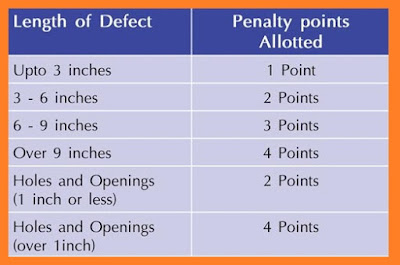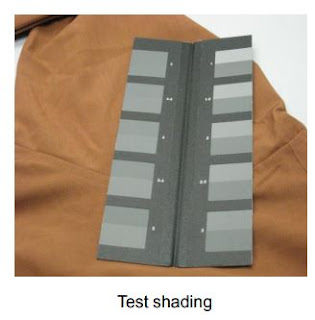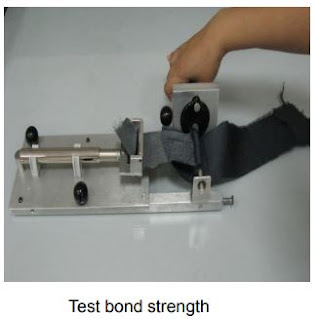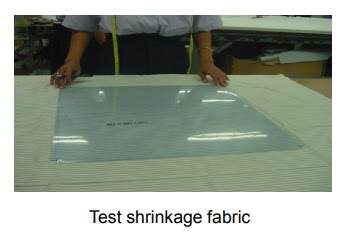Step by step of Fabric Inspection
Good quality on the garment so it depends on the quality of
the fabric / fabric when received in the form of a roll. Normally, we check 10%
of the roll we receive and check it based on the four-point system. In this way
we can analyze and inform the fabric status to be followed up immediately
before going to the production process
Four-Point System: The number examined is at least 10% of the total rolls
received. Roll selection: Choose at least one roll per color. If more
than one role must be selected, then choose an additional roll in proportion to
the number of roles per color received.
4-Point Inspection System: Four-Point System, a standard established under ASTM D5430
- 07(2011), is a standardized Test Methods for fabric Visually Inspecting and
Grading. Four-Point System is widest acceptance in fabric inspection due to its
practical, impartial, and worldwide recognized. The four-point system derives
its name from the basic grading rule that a maximum of four penalty points can
be assessed for any single defect and that no linear meter can be assigned more
than four points regardless of the number of defects within that piece.
Defect Classification (4-Point System):
Size Defect Penalty
The length of the defect used to determine the penalty
point. Only major defects are considered. There are no penalty points assigned
to minor defects. (A major defect is any defect that will cause the final
garment to be considered seconds.)
Major Defect: Defect the main woven fabrics including but not limited
to slubs, holes, missing threads, yarn variations, finally exits, dirty
threads, and wrong threads. Dyeing or defect outgoing print, colored spots, stopping
the machine, exit color, smear color, or shadow. Acceptance Criteria and Calculations:
· 40 points per 100 meters is the defect level received
· # Of Points per 100 yds = # of penalty points x 100 yds
checked
Inspection Procedure:
- Receive approval color and quality swatches
- Check lot size, lot number, roll number etc.
- Randomly draw 10% of the lot or as per AQL chart.
- Delivery of less than 1,000 yds-100% inspection
- Delivery of 1,000 yds to 10,000 yds. to inspect at list 1,000 yds.
- Delivery of more than 10,000 yds. inspection 10 of the lot.
- Check that the roll contains the correct yardage as stated by the source of a piece of goods.
- Check for slanted, biased, and bent fabrics.
- Mark each defect with colored ribbons so they can be easily found and recorded.
- Record any defects
CUTTING PROCESS
QUALITY CONTROL IN CUTTING: Cutting is the process of cutting fabric according to
existing marker patterns and the correctness of the markers and QC cutting has
been checked.
In brief what is done by the QC cutting section is checking
the fabric mat, the fabric does not wave, does not fold, the bottom to top
fabric must be the same, and the fabric shrinkage. Then check the results of
the piece, the piece must be in accordance with the sample and size tolerance.
Inspection procedure
on cutting (QC Cutting):
- Check the top sheet of cloth up to the bottom sheet of paper with the position of the marker paper.
- Check and match the pattern component with the pattern component found on the marker paper whether the pattern component is complete or not. The QC officer must record all findings on the inspection report sheet.
- Check whether or not there are cut errors on each component line.
- Check interlining with patterns (if garment components use interlining and embroidery)
- Error cutting on the part that should have been re-cut on the spare cloth, recorded and re-cut
More details are as follows
- Check the fabric construction, fabric color, fabric design, the inside of the fabric, and the fabric center line. Also checks the fabric quality.
- Check the markers, whether the size / size ratio has fulfilled all the ordered sizes
- Check the results of spreading / whether the cloth that was stranded was completely flat and not wavy and straight.
- Check the cutting method
- Inspection of cut results, whether all cut results are really in accordance with the original pattern / pattern provided by the buyer / buyer.
- Check the results of the cut, whether the stripe or box of the component pieces is really matching and balancing
TESTING OF RAW MATERIALS (FABRIC)
Fastness and Color Blemishes Tests for Washing
Launder Test Equipment with tubes and steel balls (20 pcs),
Neutral PH Soap 0.2% Volume - 100
milliliters, 40 degrees centigrade, 15 x 5 cm test sample,
15 x 5 cm Polyester and Cotton test indicator
(sandwich) cut in two short sides, test time 45 minutes.
(Test results in Gray Scale values and
Staining Scale)
Fabric Dimension Stability Testing Against Washing
Household Washing Machines with temperature control, Soap
PH approaches Neutral 0.5% by volume, 40 degrees Celsius, Examples of 70 x 70
cm - tested on all sides, test time 45 minutes. (Test results in%)
Twisted Testing Fabrics for Washing
Household washing machines with temperature control, Soap
PH approaches Neutral 0.5% by volume, 40 degrees Celsius, Test Example 70 x 70
cm, Testing time 45 minutes. (Test results in degrees or%)
Printing Testing of Washing
Household Washing Machines with temperature control, Soap
PH approaches Neutral 0.5% Volume, 40 degrees Celsius, Testing time 45 minutes.
(Test results visually)
Printing Testing of Pulls and Rubbing
Printing example, pull 150% initial length with a distance
of 5 cm from the outer edge of printing. (Visual test results) Example of
printing rubbed by hand 5 times. (Visual test results)
You May Also Like:
- Calibration Garment tape measurement
- During Production Inspection
- Top Garments defect
- Garments Pre-shipment Inspection
- How to Process Cutting on Garments
- How to Measure of Garments
- Needle Detector
- Process Sewing of Garments
- How to Process Washing Denim
- Quality Control Garments System
- Soft-Lines Pre-shipment Inspection
- Step how to setting QC and QA Garments







Belum ada Komentar untuk "Step by step of Fabric Inspection"
Posting Komentar